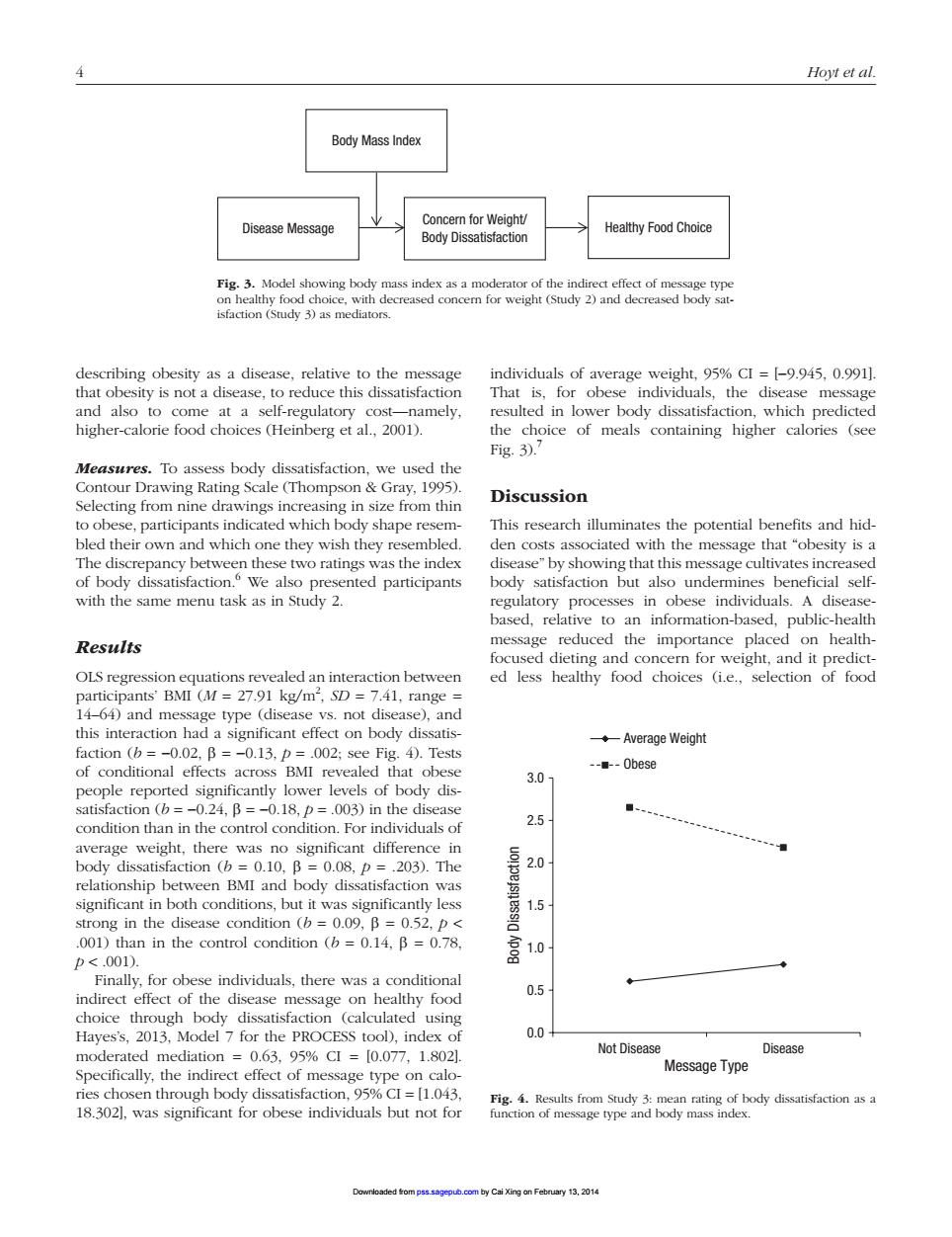正在加载图片...

Hoyt et al. Body Mass Index DseaMesage ealthy Food Choic describing obesity asa disease relativ individuals of av eight,95%C=【-9.945,0.991 that oh me and also to come at a self-regulatory cost-namely, resulted in lower body dissatisfaction,which predicted higher-calorie food choices (Heinberg et al.,2001). geof meal onnng d the ing Rat on Gray.1995) Selecting from nine drawings increasing in size from thin Discussion to obese,participants indicated which body shape resem- This research illuminates the potential benefits and hid eir own a d which one they wish they re sity is 2 ants regulatory processes in obese individuals.A disease based,relative to an information-based,public-health Results g9 reduced the importance placed on health OLS regre 2 disease),and ant effect on body ◆-Average Weigh ditional offocts aled that ----Obese 30 25 relationshin between bMi and body dissatisfaction was significant in both conditions,but it was significantly less strong in the disease condition (b=0.09.B=0.52.p< p<.001 an in the control condition (=0.14.B=0.78. Finally,for obese individuals,there was a conditional indirect effect of the disease message on healthy food 05 choice through sfaction (calculated usin唱 Hayes's, ,n 0.0 Not Disease Disease Specifically the indirect effect of me on cale Message Type 18.302].was significant for obese individuals but not for 1.201 4 Hoyt et al. describing obesity as a disease, relative to the message that obesity is not a disease, to reduce this dissatisfaction and also to come at a self-regulatory cost—namely, higher-calorie food choices (Heinberg et al., 2001). Measures. To assess body dissatisfaction, we used the Contour Drawing Rating Scale (Thompson & Gray, 1995). Selecting from nine drawings increasing in size from thin to obese, participants indicated which body shape resembled their own and which one they wish they resembled. The discrepancy between these two ratings was the index of body dissatisfaction.6 We also presented participants with the same menu task as in Study 2. Results OLS regression equations revealed an interaction between participants’ BMI (M = 27.91 kg/m2 , SD = 7.41, range = 14–64) and message type (disease vs. not disease), and this interaction had a significant effect on body dissatisfaction (b = −0.02, β = −0.13, p = .002; see Fig. 4). Tests of conditional effects across BMI revealed that obese people reported significantly lower levels of body dissatisfaction (b = −0.24, β = −0.18, p = .003) in the disease condition than in the control condition. For individuals of average weight, there was no significant difference in body dissatisfaction (b = 0.10, β = 0.08, p = .203). The relationship between BMI and body dissatisfaction was significant in both conditions, but it was significantly less strong in the disease condition (b = 0.09, β = 0.52, p < .001) than in the control condition (b = 0.14, β = 0.78, p < .001). Finally, for obese individuals, there was a conditional indirect effect of the disease message on healthy food choice through body dissatisfaction (calculated using Hayes’s, 2013, Model 7 for the PROCESS tool), index of moderated mediation = 0.63, 95% CI = [0.077, 1.802]. Specifically, the indirect effect of message type on calories chosen through body dissatisfaction, 95% CI = [1.043, 18.302], was significant for obese individuals but not for individuals of average weight, 95% CI = [−9.945, 0.991]. That is, for obese individuals, the disease message resulted in lower body dissatisfaction, which predicted the choice of meals containing higher calories (see Fig. 3).7 Discussion This research illuminates the potential benefits and hidden costs associated with the message that “obesity is a disease” by showing that this message cultivates increased body satisfaction but also undermines beneficial selfregulatory processes in obese individuals. A diseasebased, relative to an information-based, public-health message reduced the importance placed on healthfocused dieting and concern for weight, and it predicted less healthy food choices (i.e., selection of food Healthy Food Choice Concern for Weight/ Body Dissatisfaction Disease Message Body Mass Index Fig. 3. Model showing body mass index as a moderator of the indirect effect of message type on healthy food choice, with decreased concern for weight (Study 2) and decreased body satisfaction (Study 3) as mediators. 0.0 0.5 1.0 1.5 2.0 2.5 3.0 Not Disease Disease Body Dissatisfaction Message Type Average Weight Obese Fig. 4. Results from Study 3: mean rating of body dissatisfaction as a function of message type and body mass index. Downloaded from pss.sagepub.com by Cai Xing on February 13, 2014